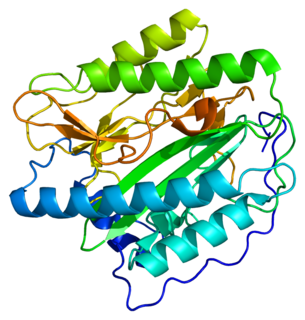
Selenocysteine is the 21st proteinogenic amino acid. Selenoproteins contain selenocysteine residues. Selenocysteine is an analogue of the more common cysteine with selenium in place of the sulfur.

In biology, the SECIS element is an RNA element around 60 nucleotides in length that adopts a stem-loop structure. This structural motif directs the cell to translate UGA codons as selenocysteines. SECIS elements are thus a fundamental aspect of messenger RNAs encoding selenoproteins, proteins that include one or more selenocysteine residues.
In molecular biology a selenoprotein is any protein that includes a selenocysteine amino acid residue. Among functionally characterized selenoproteins are five glutathione peroxidases (GPX) and three thioredoxin reductases, (TrxR/TXNRD) which both contain only one Sec. Selenoprotein P is the most common selenoprotein found in the plasma. It is unusual because in humans it contains 10 Sec residues, which are split into two domains, a longer N-terminal domain that contains 1 Sec, and a shorter C-terminal domain that contains 9 Sec. The longer N-terminal domain is likely an enzymatic domain, and the shorter C-terminal domain is likely a means of safely transporting the very reactive selenium atom throughout the body.

Selenoprotein S, also known as SELS, is a human gene.

Selenide, water dikinase 1 is an enzyme that in humans is encoded by the SEPHS1 gene.

Cytochrome b-c1 complex subunit 1, mitochondrial is a protein that in humans is encoded by the UQCRC1 gene.

Selenoprotein N is a protein that in humans is encoded by the SEPN1 gene.

SECIS-binding protein 2 is a protein that in humans is encoded by the SECISBP2 gene.

15 kDa selenoprotein is a protein that in humans is encoded by the SEP15 gene. Two alternatively spliced transcript variants encoding distinct isoforms have been found for this gene.

Peptide methionine sulfoxide reductase (Msr) is a family of enzymes that in humans is encoded by the MSRA gene.

40S ribosomal protein S11 is a protein that in humans is encoded by the RPS11 gene.

Methionine aminopeptidase 1 is an enzyme that in humans is encoded by the METAP1 gene.

Selenoprotein W is a protein that in humans is encoded by the SEPW1 gene.

Methionine-R-sulfoxide reductase B2, mitochondrial is an enzyme that in humans is encoded by the MSRB2 gene. The MRSB2 enzyme catalyzes the reduction of methionine sulfoxide to methionine.

Zinc finger protein 346 is a protein that in humans is encoded by the ZNF346 gene.

Type II iodothyronine deiodinase is an enzyme that in humans is encoded by the DIO2 gene.

Cob(I)yrinic acid a,c-diamide adenosyltransferase, mitochondrial is an enzyme that in humans is encoded by the MMAB gene.

Selenoprotein T, also known as SELT, is a protein that in humans is encoded by the SELT gene.

Glutathione peroxidase 5 (GPx-5), also known as epididymal secretory glutathione peroxidase is an enzyme that in humans is encoded by the GPX5 gene.

Glutathione peroxidase 6 (GPx-6) is an enzyme that in humans is encoded by the GPX6 gene.




















